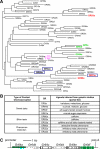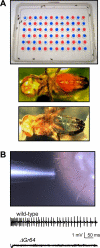A taste of the Drosophila gustatory receptors
- PMID: 19660932
- PMCID: PMC2747619
- DOI: 10.1016/j.conb.2009.07.001
A taste of the Drosophila gustatory receptors
Abstract
Insects such as the fruit fly, Drosophila melanogaster, rely on contact chemosensation to detect nutrient-rich foods, to avoid consuming toxic chemicals, and to select mates and hospitable zones to deposit eggs. Flies sense tastants and nonvolatile pheromones through gustatory bristles and pegs distributed on multiple body parts including the proboscis, wing margins, legs, and ovipositor. The sensilla house gustatory receptor neurons, which express members of the family of 68 gustatory receptors (GRs). In contrast to mammalian chemosensation or Drosophila olfaction, which are initiated by receptors composed of dimers of one or two receptor types, the functional Drosophila GRs may include three or more subunits. Several GRs appear to be expressed in multiple cell types that are not associated with contact chemosensation raising the possibility that these proteins may have roles that extend beyond the detection of tastants and pheromones.
Figures



Similar articles
-
A Drosophila gustatory receptor essential for aversive taste and inhibiting male-to-male courtship.Curr Biol. 2009 Oct 13;19(19):1623-7. doi: 10.1016/j.cub.2009.07.061. Epub 2009 Sep 17. Curr Biol. 2009. PMID: 19765987 Free PMC article.
-
The Drosophila IR20a clade of ionotropic receptors are candidate taste and pheromone receptors.Neuron. 2014 Aug 20;83(4):850-65. doi: 10.1016/j.neuron.2014.07.012. Epub 2014 Aug 7. Neuron. 2014. PMID: 25123314 Free PMC article.
-
A putative Drosophila pheromone receptor expressed in male-specific taste neurons is required for efficient courtship.Neuron. 2003 Sep 11;39(6):1019-29. doi: 10.1016/s0896-6273(03)00542-7. Neuron. 2003. PMID: 12971900
-
Taste and pheromone perception in the fruit fly Drosophila melanogaster.Pflugers Arch. 2007 Aug;454(5):735-47. doi: 10.1007/s00424-007-0246-y. Epub 2007 May 1. Pflugers Arch. 2007. PMID: 17473934 Review.
-
Sexy DEG/ENaC channels involved in gustatory detection of fruit fly pheromones.Sci Signal. 2012 Nov 6;5(249):pe48. doi: 10.1126/scisignal.2003555. Sci Signal. 2012. PMID: 23131844 Review.
Cited by
-
Structure basis for sugar specificity of gustatory receptors in insects.Cell Discov. 2024 Aug 6;10(1):83. doi: 10.1038/s41421-024-00716-6. Cell Discov. 2024. PMID: 39103325 Free PMC article. No abstract available.
-
Motor neurons controlling fluid ingestion in Drosophila.Proc Natl Acad Sci U S A. 2012 Apr 17;109(16):6307-12. doi: 10.1073/pnas.1120305109. Epub 2012 Apr 2. Proc Natl Acad Sci U S A. 2012. PMID: 22474379 Free PMC article.
-
Measuring Physiological Responses of Drosophila Sensory Neurons to Lipid Pheromones Using Live Calcium Imaging.J Vis Exp. 2016 Apr 29;(110):53392. doi: 10.3791/53392. J Vis Exp. 2016. PMID: 27168110 Free PMC article.
-
Adaptive Physiological Response to Perceived Scarcity as a Mechanism of Sensory Modulation of Life Span.J Gerontol A Biol Sci Med Sci. 2015 Sep;70(9):1088-91. doi: 10.1093/gerona/glv039. Epub 2015 Apr 15. J Gerontol A Biol Sci Med Sci. 2015. PMID: 25878032 Free PMC article.
-
Antennal Transcriptome Screening and Identification of Chemosensory Proteins in the Double-Spine European Spruce Bark Beetle, Ips duplicatus (Coleoptera: Scolytinae).Int J Mol Sci. 2024 Sep 1;25(17):9513. doi: 10.3390/ijms25179513. Int J Mol Sci. 2024. PMID: 39273461 Free PMC article.
References
-
- Clyne PJ, Warr CG, Carlson JR. Candidate taste receptors in Drosophila. Science. 2000;287:1830–1834. - PubMed
-
- Scott K, Brady R, Jr., Cravchik A, Morozov P, Rzhetsky A, Zuker C, Axel R. A chemosensory gene family encoding candidate gustatory and olfactory receptors in Drosophila. Cell. 2001;104:661–673. - PubMed
-
- Ueno K, Ohta M, Morita H, Mikuni Y, Nakajima S, Yamamoto K, Isono K. Trehalose sensitivity in Drosophila correlates with mutations in and expression of the gustatory receptor gene Gr5a. Curr. Biol. 2001;11:1451–1455. - PubMed
-
- Dahanukar A, Foster K, van der Goes van Naters WM, Carlson JR. A Gr receptor is required for response to the sugar trehalose in taste neurons of Drosophila. Nat. Neurosci. 2001;4:1182–1186. - PubMed
Publication types
MeSH terms
Substances
Grants and funding
LinkOut - more resources
Full Text Sources
Molecular Biology Databases

